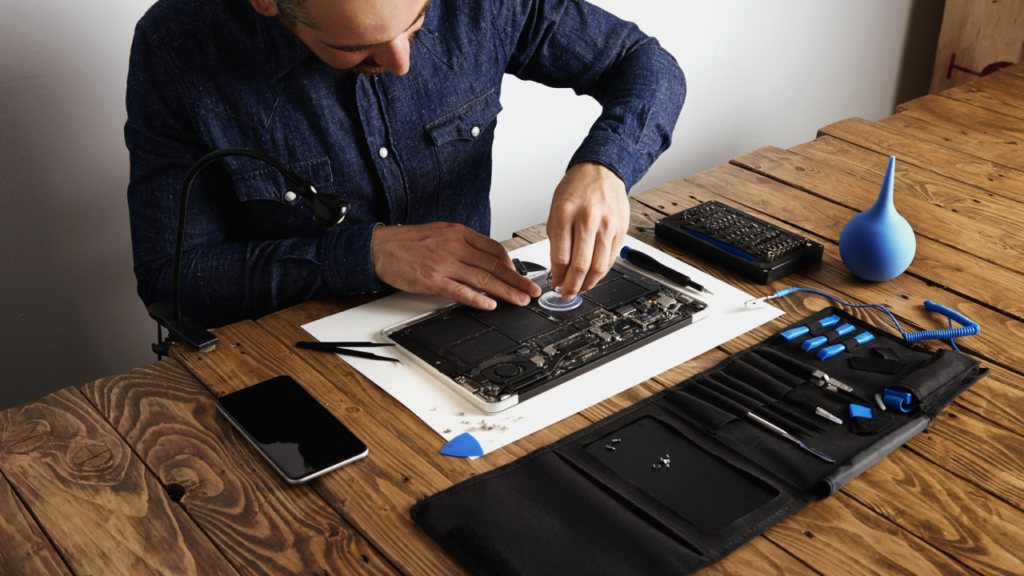Introduction
The Critical Importance of Hardware Maintenance For small businesses operating with limited IT resources, proper hardware maintenance isn’t just a recommendation – it’s a necessity for survival. Unlike large corporations with dedicated IT departments, small businesses often rely on a handful of critical devices to keep operations running smoothly. When hardware fails, the consequences can be devastating – from lost productivity and revenue to potential data disasters.
Proactively prevent hardware failures before they occur
Extend the lifespan of your technology investments
Maintain optimal system performance
Protect your valuable business data
Create a sustainable maintenance routine that fits your operations
Understanding Hardware Lifespans and Failure Points
Typical Lifespans of Common Business Hardware
Before diving into maintenance, it’s important to understand how long business hardware should reasonably last:
- Laptops/Desktops: 3-5 years
- Servers: 5-7 years
- Network Equipment (routers/switches): 4-6 years
- Printers: 3-5 years
- POS Systems: 5-7 years
- External Storage Devices: 3-5 years
These lifespans assume proper maintenance – neglected devices may fail much sooner.
Most Common Points of Hardware Failure
Understanding where failures typically occur helps focus maintenance efforts:
- Storage Devices: HDDs/SSDs fail due to wear, heat, or power issues
- Cooling Systems: Fans clog with dust, thermal paste dries out
- Power Supplies: Voltage fluctuations cause premature failure
- Batteries: Laptop/tablet batteries degrade over time
- Moving Parts: Printers and scanners have wear-prone mechanisms
Creating a Hardware Maintenance Schedule
Daily Maintenance Tasks
- Visual Inspections: Quick check for obvious issues (overheating, strange noises)
- Backup Verification: Confirm automated backups completed successfully
- Performance Monitoring: Note any slowdowns or unusual behavior
Weekly Maintenance Tasks
- Dust Removal: Compressed air cleaning of vents and keyboards
- Software Updates: Check for and install critical updates
- Disk Cleanup: Remove temporary files and clear caches
Monthly Maintenance Tasks
- Full System Scans: Run antivirus and malware scans
- Hardware Diagnostics: Check SMART status on drives, test RAM
- Cable Management: Inspect and organize cables to prevent damage
Quarterly Maintenance Tasks
- Deep Cleaning: Full internal cleaning (for desktops/servers)
- Thermal Paste Replacement: For CPUs in high-use systems
- Battery Checks: Test laptop/tablet battery health
Annual Maintenance Tasks
- Preventative Replacements: Swap aging components before failure
- Surge Protector Testing: Ensure proper electrical protection
- Full System Evaluation: Assess if upgrades are needed
Advanced Maintenance Techniques
Environmental Considerations
Hardware performance and longevity are significantly affected by:
- Temperature: Ideal range is 68-75°F (20-24°C)
- Humidity: Maintain 40-60% relative humidity
- Air Quality: Dust, smoke, and pollutants accelerate wear
- Vibration: Can damage mechanical components over time
Power Protection Strategies
Surge Protectors: Essential for all electronic equipment
- UPS Systems: Battery backups for critical devices
- Voltage Regulators: In areas with unstable power
- Proper Grounding: Prevents electrical damage
Data Preservation Methods
- 3-2-1 Backup Rule: 3 copies, 2 media types, 1 offsite
- Cloud Backups: Automated, offsite protection
- Local Backups: External drives or NAS devices
- Verification: Regularly test backup integrity
Troubleshooting Common Hardware Issues
Diagnostic Tools Every Business Should Have
- Multimeter: For electrical testing
- POST Card: Diagnoses startup issues
- Hard Drive Cloner: Data recovery tool
- Thermal Camera: Identifies overheating components
- Loopback Plugs: Tests network ports
Step-by-Step Troubleshooting Guide
- Identify Symptoms: Document exact error messages/behaviors
- Isolate Components: Test hardware individually when possible
- Check Connections: Reseat cables and components
- Update Drivers/Firmware: Often resolves compatibility issues
- Consult Documentation: Manufacturer resources may have specific solutions
When to Repair vs. Replace
Cost-Benefit Analysis Framework
- Consider these factors when deciding between repair and replacement:
- Age of Equipment: Older than 5 years? Probably replace
- Repair Costs: Exceeds 50% of replacement cost? Replace
- Downtime Impact: How critical is immediate availability?
- Warranty Status: Covered repairs are often worth doing
- Future Needs: Will the device meet requirements for another 2+ years?
Conclusion
Protect Your Business with Proactive Hardware Maintenance For small businesses, hardware failures aren’t just inconveniences—they can lead to costly downtime, lost productivity, and even data disasters. By implementing a structured hardware maintenance routine, you can significantly extend the lifespan of your equipment, prevent unexpected breakdowns, and maintain peak performance. Simple practices like regular cleaning, performance monitoring, and proactive backups can save thousands in repair costs and keep your operations running smoothly.

